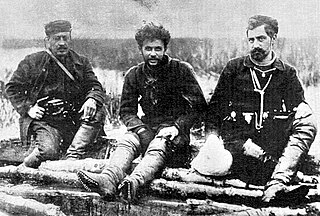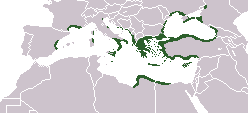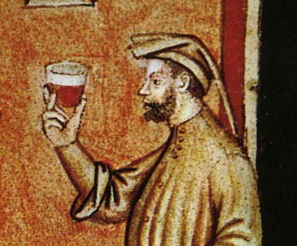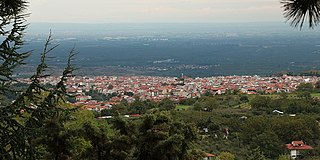
A vineyard is a plantation of grape-bearing vines, grown mainly for winemaking, but also raisins, table grapes and non-alcoholic grape juice. The science, practice and study of vineyard production is known as viticulture.

Imathia is one of the regional units of Greece. It is part of the region of Central Macedonia. The capital of Imathia is the city of Veroia.

Agiorgitiko is a red Greek wine grape variety that, as of 2012, was the most widely planted red grape variety in Greece, ahead of Xynomavro. The grape has traditionally been grown in the Nemea region of the Peloponnese but can be found throughout the country including Attikí (Attica) and Makedonía (Macedonia).

Greece is one of the oldest wine-producing regions in the world and among the first wine-producing territories in Europe. The earliest evidence of Greek wine has been dated to 6,500 years ago where wine was produced on a household or communal basis. In ancient times, as trade in wine became extensive, it was transported from end to end of the Mediterranean; Greek wine had especially high prestige in Italy under the Roman Empire. In the medieval period, wines exported from Crete, Monemvasia and other Greek ports fetched high prices in northern Europe.

Agriculture in Greece is based on small-sized, family-owned dispersed units, while the extent of cooperative organization stays at low comparative levels, against all efforts that have been taken in the last 30 years, mainly under European Union supervision. Greek agriculture employs 528,000 farmers, 12% of the total labor force. It only produces 3.6% of the national GDP. A large number of the country's immigrants are employed in the agricultural sector of the economy, as well as construction and public works.
American wine has been produced for over 300 years. Today, wine production is undertaken in all fifty states, with California producing 89 percent of all US wine. The United States is the fourth-largest wine producing country in the world, after Italy, Spain, and France.

Nymfaio, is a predominantly Aromanian (Vlach) village and a former community in Florina regional unit, West Macedonia, Greece. After the 2011 local government reform it became a member of the municipality Amyntaio. The municipal unit has an area of 28.209 km2. As of 2011 the village had a population of 132 residents. The village is protected by the Hellenic Ministry of Culture in order to preserve its architectural integrity.

The earliest archaeological evidence of wine produced from grapes, has been found at sites in China, Georgia, Iran, Greece, and Sicily. The oldest evidence of wine production has been found in Armenia.
Anastasios Karatasos was a Greek military commander during the Greek War of Independence was born in the village of Dovras, Imathia and is considered to be the most important revolutionary from Macedonia.
Zafeirakis Theodosiou was a Greek prokritos (πρόκριτος), meaning political leader of Greeks during Ottoman rule, of Naousa, Imathia and an important figure of the Greek War of Independence in the region of Macedonia.

Tellos Agras was the nom de guerre of Sarantis-Tellos Agapinos, a Greek officer of the Hellenic Army who played a prominent role during the Greek Struggle for Macedonia.

The influence of wine in ancient Greece helped ancient Greece trade with neighboring countries and regions. Many mannerisms and cultural aspects were associated with wine. It led to great change in Ancient Greece as well.
Tsantali is a Greek wine and liquor producer. The company was founded in East Thrace, and originally produced ouzo and tsipouro. After its move westward to Macedonia, it increasingly focused on wine production, which by 2005 accounted for approximately four-fifths of its production volume and just under half its revenue, making it one of the two major wine companies of Macedonia. As of 2005, it owned 260 hectares of vineyards and had another 1,250 ha under contract, and produced 16–20 million liters of wine per year. Of its exports, approximately 65% go to Germany. The company has a particular reputation for reviving wine styles with historical associations, of which the Rapsani and Agion Oros lines have been its most successful.

Old World wine refers primarily to wine made in Europe but can also include other regions of the Mediterranean basin with long histories of winemaking such as North Africa and the Near East. The phrase is often used in contrast to "New World wine" which refers primarily to wines from New World wine regions such as the United States, Australia, South America and South Africa. The term "Old World wine" does not refer to a homogeneous style with "Old World wine regions" like Austria, France, Italy, Portugal, and Spain each making vastly different styles of wine even within their own borders. Rather, the term is used to describe general differences in viticulture and winemaking philosophies between the Old World regions where tradition and the role of terroir lead versus the New World where science and the role of the winemaker are more often emphasized. In recent times, the globalization of wine and advent of flying winemakers have lessened the distinction between the two terms with winemakers in one region being able to produce wines that can display the traits of the other region—i.e. an "Old World style" wine being produced in a New World wine region like California or Chile and vice versa.

The Wine Museum is a museum of wine and viticulture located in Pleven, a city in north central Bulgaria. Opened on 17 September 2008, the museum occupies a natural cave in Pleven's Kaylaka park, about 5 kilometres (3.1 mi) from the city centre.

Yiannis Boutaris is a Greek businessman, politician and current mayor of Thessaloniki.

Santorini is a Greek wine region located on the archipelago of Santorini in the southern Cyclades islands of Greece. Wine has been produced there since ancient times, but it was during the Middle Ages that the wine of Santorini became famous worldwide under the influence of the Republic of Venice. The Italian influence is still present in modern Santorini winemaking: the most famous Tuscan sweet wine is called Vin Santo. Santorini's Vin Santo is made in a passito style from grapes dried in the sun after harvest. Santorini also produces blended and rosé wine made from white grapes such as Athiri, Aidini and Assyrtiko, and red grapes such as Mandelaria.

The Folklore Museum is located in Naoussa, Central Macedonia, Greece. It was founded in 1968 by the Lyceum of Hellenic Women with the aim of saving and preserving the customs of Naoussa and the surrounding area. The premises were supplied by the Municipality of Naoussa in the park near the entrance to the town.
Romeiko is a red grape variety indigenous to Greece. Its name derives from the term Romios that is used to refer to modern Greeks.




















